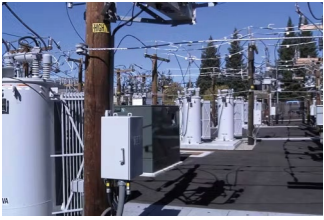As PG&E continues to evolve our grid management strategies, expanding load management capabilities across all levels of the system is crucial. With PG&E is expecting load to double by 2040, we need grid-enhancing solutions that create new ways to transform distributed energy resources and EVs into grid assets.
 |
PS8. Modeling and predicting grid impacts from large load ramping |
Large data centers can pose a significant challenge to transmission system balancing when their load drops off or ramps up suddenly. These step changes in demand can cause operational stress and reliability risks for both local substations and the broader transmission system. As PG&E begins to explore ways to accelerate interconnection timelines, they are beginning to request load flexibility, such as the ability to partially curtail or ramp down data center loads on demand, as a condition for siting. However, there is currently no robust, research-based scenario modeling capability to predict when and where these step changes become problematic, how they interact with high penetrations of inverter-based resources (IBRs) like large-scale solar and batteries, and what mix of technologies or operational practices is most effective for mitigation. |
|
|
Why is this important? As the number and size of hyperscale data centers grow, their instantaneous load behaviors can create shock events that impact grid stability and require fast-responding backup capacity. If these facilities could behave more like “soft start” motors, ramping on and off gradually, their integration would become less disruptive to both transmission and distribution systems. Understanding the conditions under which these ramps create system-wide problems, especially when co-located with dense (inverter-based resources) IBR clusters, is critical for resilient grid operations and cost-effective interconnections. |
|
|
What is the current state and its primary limitations? While many data centers can modulate internally, they still often appear to the grid as abrupt, large net load changes, coming online or offline in bulk with little external coordination. Grid operators typically have limited visibility or control over these transitions, making it difficult to anticipate or mitigate their impact on system stability. PG&E currently lacks data and models that can capture the detailed interactions between large flexible loads and local clusters of IBRs, including potential “wave” effects that can cascade through the system and trigger voltage and frequency issues.
Primary limitations include:
|
|
|
What are the desired outcomes from R&D? PG&E seeks to identify and adapt research-grade scenario modeling tools and supporting frameworks that can be directly incorporated into its system planning and operations, with desired outcomes as follows:
|
|
 |
PS6. Enhancing visibility into DER and EV load flexibility potential |
| PG&E lacks consistent visibility into the device type, location, program participation, and energy usage data of existing and new DER customers. Further, PG&E lacks data on the historical and real-time performance potential of these DERs as sources of grid flexibility and accurate forecasts of performance when those resources are called upon. This poses a major challenge for distribution and transmission planning and operations and is a barrier to designing and implementing targeted load management programs at the system level and the distribution level. | |
| Why Is this important?
Visibility into Distributed Energy Resources (DER) and Electric Vehicle (EV) load data is crucial for PG&E for several key reasons. First, the inability to predict the demand expected from DERs when relying primarily on aggregated meter data creates challenges in accurately forecasting energy needs and ensuring reliable grid operations. Second, without detailed information, PG&E cannot assess the flexibility potential of DERs, including EVs, which limits our ability to leverage these assets for grid stability and efficiency. Lastly, the lack of visibility into how much of this flexibility potential can be captured under the right incentive structures challenges PG&E when seeking to design and implement highly effective load management programs. At the CAISO level, the unpredictable nature of DER behavior is starting to destabilize both day-ahead and real -time forecasting models, driving a need for last-minute procurement of expensive resources, with costs ultimately passed to ratepayers. Addressing these gaps is essential for enhancing grid reliability, optimizing resource use, and supporting the sustainable and efficient integration of renewable energy. Additionally, real-world DER performance data will provide essential inputs into orchestration strategies, creating a feedback loop between visibility and dispatch optimization. |
|
| What Is the current state and its primary limitations?
While most DERs are connected to the internet and store location and usage data, these data are not consistently available to PG&E. Beyond site-level meter (Advanced Metering Infrastructure) data at the hourly or 15-minute interval level, PG&E lacks a comprehensive system to collect essential information about non-market participating resources, which influences accurate forecasting. While the existing AMI data provides site-level consumption data, it does not differentiate between behind-the-meter device-level performance (e.g., individual DERs or EV chargers). As a result, PG&E needs solutions that can both leverage existing AMI data and go beyond to identify DERs we don’t know about and monitor their real-time operational status, unlocking more precise forecasting and flexible load orchestration. Questions we must be able to answer with better data and better forecasts include: what programs are DERs participating in, who is operating them, what are the performance duration and fatigue limitations, and what forms of automation are they capable of using?
Primary limitations include:
|
|
| What are the desired outcomes from R&D?
Novel technologies, including AI/ML, to:
|
|
|
Submit Application
Please fill out the entirety of the form below to the best of your ability.
Browse Ideas
Review your submitted projects.
|
Terms and Conditions | Contact Us: noreply@brightidea.com |



